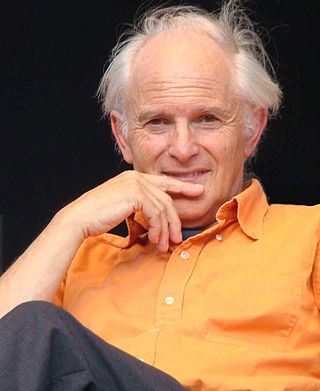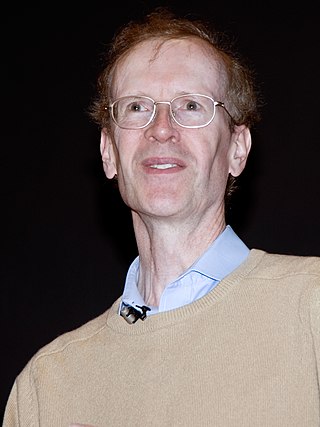Related Research Articles

A fullerene is an allotrope of carbon whose molecule consists of carbon atoms connected by single and double bonds so as to form a closed or partially closed mesh, with fused rings of five to seven atoms. The molecule may be a hollow sphere, ellipsoid, tube, or many other shapes and sizes. Graphene, which is a flat mesh of regular hexagonal rings, can be seen as an extreme member of the family.

Sir Harold Walter Kroto, known as Harry Kroto, was an English chemist. He shared the 1996 Nobel Prize in Chemistry with Robert Curl and Richard Smalley for their discovery of fullerenes. He was the recipient of many other honors and awards.

Robert Floyd Curl Jr. was an American chemist who was Pitzer–Schlumberger Professor of Natural Sciences and professor of chemistry at Rice University. He was awarded the Nobel Prize in Chemistry in 1996 for the discovery of the nanomaterial buckminsterfullerene, and hence the fullerene class of materials, along with Richard Smalley and Harold Kroto of the University of Sussex.

Buckminsterfullerene is a type of fullerene with the formula C60. It has a cage-like fused-ring structure (truncated icosahedron) made of twenty hexagons and twelve pentagons, and resembles a football. Each of its 60 carbon atoms is bonded to its three neighbors.
The modularity theorem states that elliptic curves over the field of rational numbers are related to modular forms. Andrew Wiles proved the modularity theorem for semistable elliptic curves, which was enough to imply Fermat's Last Theorem. Later, a series of papers by Wiles's former students Brian Conrad, Fred Diamond and Richard Taylor, culminating in a joint paper with Christophe Breuil, extended Wiles's techniques to prove the full modularity theorem in 2001.
In complex analysis, de Branges's theorem, or the Bieberbach conjecture, is a theorem that gives a necessary condition on a holomorphic function in order for it to map the open unit disk of the complex plane injectively to the complex plane. It was posed by Ludwig Bieberbach (1916) and finally proven by Louis de Branges (1985).
The year 1994 in science and technology involved many significant events, listed below.
Ribet's theorem is part of number theory. It concerns properties of Galois representations associated with modular forms. It was proposed by Jean-Pierre Serre and proven by Ken Ribet. The proof was a significant step towards the proof of Fermat's Last Theorem (FLT). As shown by Serre and Ribet, the Taniyama–Shimura conjecture and the epsilon conjecture together imply that FLT is true.
In additive number theory, the Fermat polygonal number theorem states that every positive integer is a sum of at most nn-gonal numbers. That is, every positive integer can be written as the sum of three or fewer triangular numbers, and as the sum of four or fewer square numbers, and as the sum of five or fewer pentagonal numbers, and so on. That is, the n-gonal numbers form an additive basis of order n.
Calvin Forrest Quate was one of the inventors of the atomic force microscope. He was a professor emeritus of Applied Physics and Electrical Engineering at Stanford University.

Gerd Binnig is a German physicist. He is most famous for having won the Nobel Prize in Physics jointly with Heinrich Rohrer in 1986 for the invention of the scanning tunneling microscope.

Chandrashekhar B. Khare is a professor of mathematics at the University of California Los Angeles. In 2005, he made a major advance in the field of Galois representations and number theory by proving the level 1 Serre conjecture, and later a proof of the full conjecture with Jean-Pierre Wintenberger. He has been on the Mathematical Sciences jury for the Infosys Prize from 2015, serving as Jury Chair from 2020.
The problem in number theory known as "Fermat's Last Theorem" has repeatedly received attention in fiction and popular culture. The theorem was proved by Andrew Wiles in 1994.
James R. Heath is an American chemist and the president and professor of Institute of Systems Biology. Previous to this, he was the Elizabeth W. Gilloon Professor of Chemistry at the California Institute of Technology, after having moved from University of California Los Angeles.

Christoph Gerber is a titular professor at the Department of Physics, University of Basel, Switzerland.

In number theory, Fermat's Last Theorem states that no three positive integers a, b, and c satisfy the equation an + bn = cn for any integer value of n greater than 2. The cases n = 1 and n = 2 have been known since antiquity to have infinitely many solutions.

Wiles's proof of Fermat's Last Theorem is a proof by British mathematician Andrew Wiles of a special case of the modularity theorem for elliptic curves. Together with Ribet's theorem, it provides a proof for Fermat's Last Theorem. Both Fermat's Last Theorem and the modularity theorem were almost universally considered inaccessible to prove by contemporaneous mathematicians, meaning that they were believed to be impossible to prove using current knowledge.

C70 fullerene is the fullerene molecule consisting of 70 carbon atoms. It is a cage-like fused-ring structure which resembles a rugby ball, made of 25 hexagons and 12 pentagons, with a carbon atom at the vertices of each polygon and a bond along each polygon edge. A related fullerene molecule, named buckminsterfullerene (C60 fullerene), consists of 60 carbon atoms.
Azafullerenes are a class of heterofullerenes in which the element substituting for carbon is nitrogen. They can be in the form of a hollow sphere, ellipsoid, tube, and many other shapes. Spherical azafullerenes resemble the balls used in football (soccer). They are also a member of the carbon nitride class of materials that include beta carbon nitride (β-C3N4), predicted to be harder than diamond. Besides the pioneering work of a couple of academic groups, this class of compounds has so far garnered little attention from the broader fullerene research community. Many properties and structures are yet to be discovered for the highly-nitrogen substituted subset of molecules.

Hugo Duminil-Copin is a French mathematician specializing in probability theory. He was awarded the Fields Medal in 2022.
References
- ↑ Kroto, H. W.; Heath, J. R.; O'Brien, S. C.; Curl, R. F.; Smalley, R. E. (1985). "C60: Buckminsterfullerene". Nature . 318 (6042): 162–163. Bibcode:1985Natur.318..162K. doi:10.1038/318162a0. S2CID 4314237.
- ↑ Penguin Pocket On This Day. Penguin Reference Library. 2006. ISBN 978-0-14-102715-9.
- ↑ Farman, J. C.; Gardiner, B. G.; Shanklin, J. D. (1985). "Large losses of total ozone in Antarctica reveal seasonal ClOx/NOx interaction". Nature. 315 (6016): 207–10. Bibcode:1985Natur.315..207F. doi:10.1038/315207a0. S2CID 4346468.
- ↑ Zehr, Stephen C. (1994). "Accounting for the Ozone Hole: Scientific Representations of an Anomaly and Prior Incorrect Claims in Public Settings". The Sociological Quarterly. 35 (4): 603–19. doi:10.1111/j.1533-8525.1994.tb00419.x. JSTOR 4121521.
- ↑ Alfred, Randy (2008-02-09). "Sept. 2, 1985: Hey, Everyone, We Found the Titanic". Wired. Retrieved 2011-11-03.
- ↑ Ballard, Robert D. (December 1985). "How We Found the Titanic". National Geographic . 168 (6): 696–718.
- ↑ de Branges, Louis (1985). "A proof of the Bieberbach conjecture". Acta Mathematica . 154 (1): 137–152. doi: 10.1007/BF02392821 . MR 0772434.
- ↑ Sullivan, Dennis (1985). "Quasiconformal homeomorphisms and dynamics I. Solution of the Fatou-Julia problem on wandering domains". Annals of Mathematics . 122 (2): 401–418. doi:10.2307/1971308. JSTOR 1971308. S2CID 54186648.
- ↑ Adleman L. M.; Heath-Brown, D. R. (June 1985). "The first case of Fermat's last theorem". Inventiones Mathematicae . Berlin: Springer. 79 (2): 409–416. Bibcode:1985InMat..79..409A. doi:10.1007/BF01388981. S2CID 122537472.
- ↑ "Contact – High Technology Lends a Hand/Science of the Soundstage". Warner Bros. Archived from the original on 2001-03-04. Retrieved 2014-09-01.
- ↑ [1985] 3 All ER 402 (HL).
- ↑ "About the Cochrane Library". The Cochrane Library. Archived from the original on 2011-01-05. Retrieved 2011-01-25.
- ↑ Gaines, Larry; Miller, LeRoy (2006). Criminal Justice In Action: The Core. Thomson/Wadsworth. ISBN 978-0-495-00305-2.
- ↑ "Mobiles rack up 20 years of use". BBC News. 2005-01-01. Retrieved 2008-01-29.
- ↑ "UK's first mobile phone user remembers his call 30 years on". BBC News. 2005-01-01. Retrieved 2005-01-01.
- ↑ Binnig, G.; Quate, C. F.; Berger, Ch. (1986-03-03). "Atomic Force Microscope". Physical Review Letters . 56 (9): 930–933. Bibcode:1986PhRvL..56..930B. doi: 10.1103/PhysRevLett.56.930 . PMID 10033323.
- ↑ Cepelewicz, Jordana (2022-07-05). "Hugo Duminil-Copin Wins the Fields Medal". Quanta Magazine. Archived from the original on 2022-07-05. Retrieved 2022-07-05.